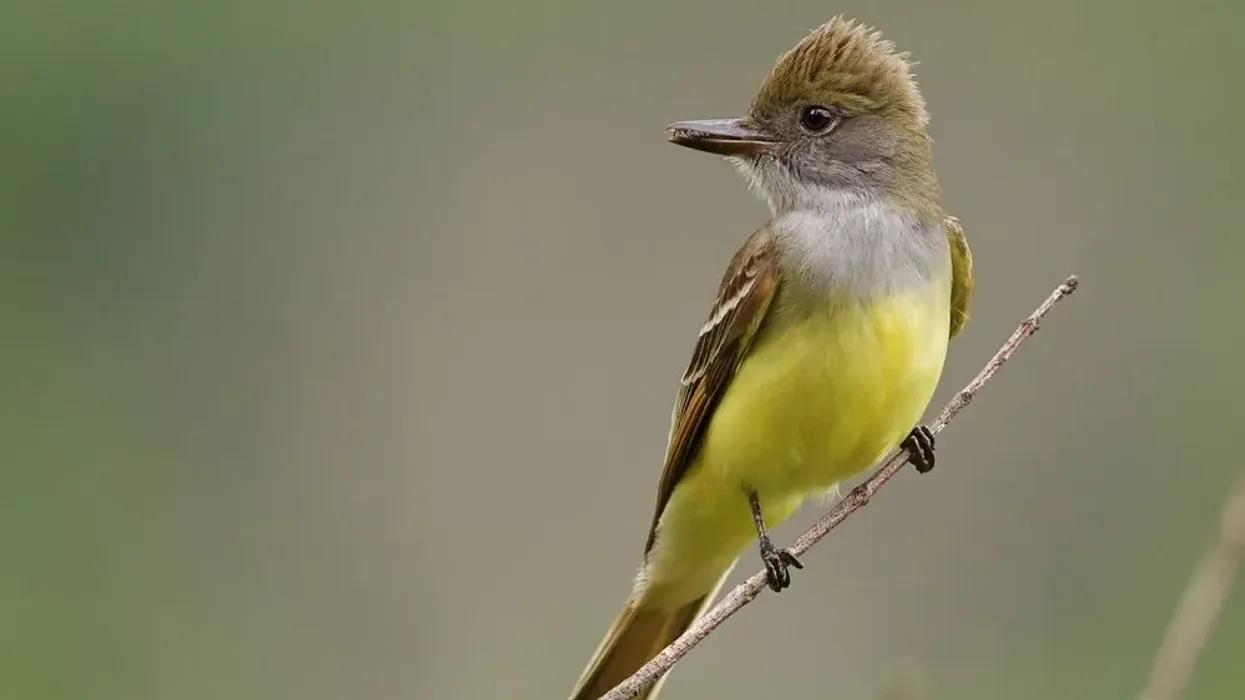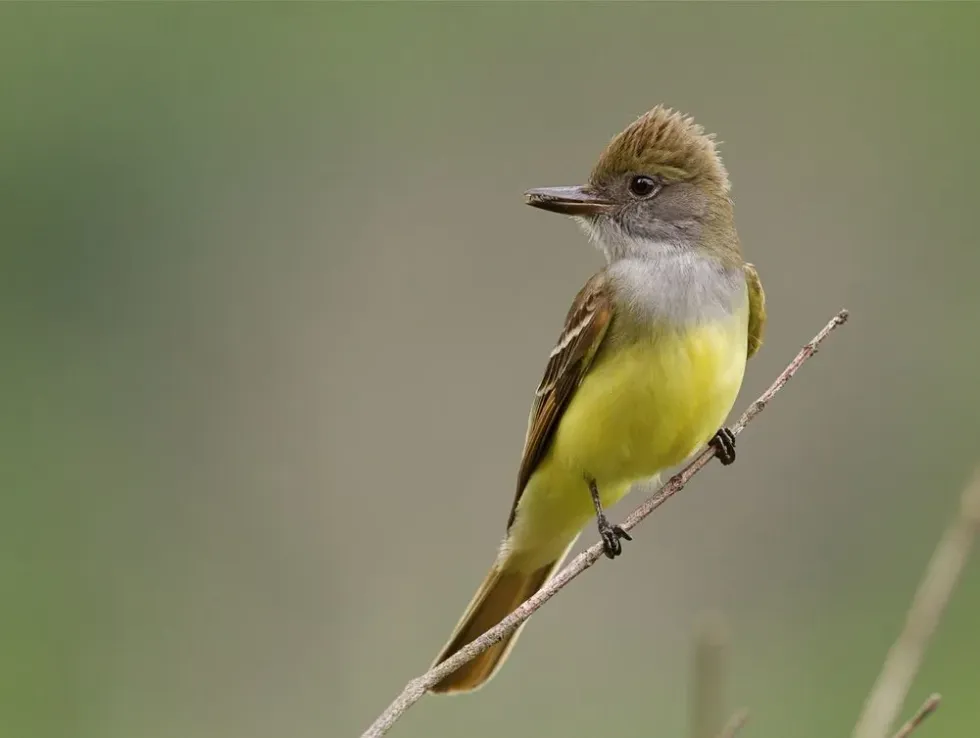Tyrant flycatchers (Tyrannidae) are one of the largest families of birds that can be found in North, South, and Central America. These birds are members of suborder Tyranni and fall under the Passeriformes order.
These birds are the most diverse avian family, and because of their large family size, the members of these species come in different shapes, sizes, and colors.
The richness of the species of this family is highly variable, and almost all habitat ranges in their native regions have these birds. They can be found all over the North and South American continent, with a majority of them being a species of least concern due to their large population.
According to the International Ornithologists' Union (IOC), there are over 400 species of the tyrant flycatchers and their relatives in the world! An astonishing number, to say the least! Some of them are Pseudocolopteryx flaviventris, Pseudocolopteryx sclateri, Myiopagis flavivertex, Phyllomyias nigrocapillus, Phyllomyias fasciatus, Phyllomyias zeledoni, and others! Read on for more facts on this bird family.
For information and facts on other birds, take a look at the blue jay and umbrellabird too!
Tyrant Flycatcher Interesting Facts
What type of animal is a tyrant flycatcher?
Tyrant flycatchers (Tyrannidae) are a family of birds that are members of suborder suboscines. They are known to be the largest order of birds consisting of over 400 species. These passerines fall under the Passeriformes order and are one of the largest numbers of birds found in the wild.
What class of animal does a tyrant flycatcher belong to?
The tyrant flycatchers (Tyrannidae) belong to the Aves class of animals. The Aves class consists solely of birds and belongs to the family of Ardeidae.
How many tyrant flycatchers are there in the world?
The tyrant flycatchers come together to form the biggest family of birds that can be found in the world.
They are large in population thanks to the 110 genera and more than 400 species that can be found all across the Central, North, and South American regions.
Some of the birds that belong to this family as the shrike tyrant, pygmy-tyrant, fork-tailed flycatcher, marsh tyrant, common tody-flycatchers, rush tyrant, bush tyrant, Alder flycatcher, and the Eastern wood-pewee with the great crested flycatcher being the most abundant flycatcher in the United States.
Where does a tyrant flycatcher live?
Due to being a part of a large family of birds, the tyrant flycatchers have vast habitats and can live in several geographic areas, which can include a rainforest, palm forest, savanna, mangroves, and deciduous forest habitat, to name a few.
These birds have well adapted to most parts of Central, South, and North America and thrive in the varying habitat distribution.
What is a tyrant flycatcher's habitat?
Tyrant flycatchers have a vast distribution range of habitat and can be found in ranges that are hot, to wet tropical forests and dry deserts; they can be found in forest interiors, evergreen forests, humid/semi-humid montane scrub, sand forests, and mountain ranges that are still habitable for insects. The flycatchers are only absent from Tundra and Arctic regions.
Who do tyrant flycatchers live with?
Tyrant flycatchers are solitary birds and are not known for forming flocks. They are territorial during the mating/breeding season, with some of them, like the kingbirds, showing aggression towards other species and driving them out.
How long do tyrant flycatchers live?
Due to the family Tyrannidae being huge, the exact lifespan of each and every species is hard to state since they live in vast habitats and have different diets.
However, from recorded data of the lifespan of species like the vermillion flycatcher, western wood-pewee, and the royal flycatcher, it can be said that the lifespan of this family of birds is up to 15 years maximum.
How do they reproduce?
Most of the members of the tyrant flycatchers are solitary in nature, even migrating alone and come together only during mating season, with pairs staying together as a sign of monogamy for the entire year-round in some species.
However, in few species like the Eastern phoebe (Sayornis phoebe), polygamy is common, and most males will mate with multiple females. Sexual maturity in these birds is usually two to three years and can vary according to the species they belong to.
Females lay two or three eggs on average, but up to six can be laid by flycatcher species living in higher latitudes.
What is their conservation status?
The conservation status of the Tyrannidae family can be confusing largely due to the immense species that can be found in the family. Species of flycatchers like the fork-tailed flycatcher, Rufous-crowned elaenia, rush tyrant, bush tyrant, shrike tyrants, pygmy-tyrants are some of the commonly known species that are listed as Least Concern on the IUCN Red List.
Nine members of the Flycatchers are listed as Endangered, with furthermore fifteen species being listed as Vulnerable on the IUCN Red List.
The reason for the population decline of the flycatcher is due to human settlements of their old habitats, which caused a widespread habitat loss of these Passeriformes.
Tyrant Flycatcher Fun Facts
What do tyrant flycatchers look like?

*Please note that this is an image of a great-crested flycatcher, not a tyrant flycatcher. If you have an image of a tyrant flycatcher, please let us know at hello@kidadl.com.
Tyrant flycatchers are small birds that are colored, with a majority of them being olive-green, brown, gray on top with lighter colors like whitish, pale yellow, and beige on the underparts. A few members of the family Tyrannidae are brightly colored like that vermilion flycatcher that has a bright red crown.
Several species of the kingbirds, another part of the family Tyrannidae, have bright yellow breasts.
The bill size of these birds depends on the diet they have. Flycatcher species that feed on small insects have a smaller bill compared to the flycatcher of the larger birds like the great shrike-tyrants that have a larger bill due to them feeding on bees, dragonflies, and other larger insects.
The Tyrannus species of the family Tyrannidae have elongated tail feathers, which can be seen on the fork-tailed flycatcher and the scissor-tailed flycatcher.
How cute are they?
The tyrant flycatcher is one of the cutest birds that can be found in the wild! Species like the pygmy-tyrant and the tit tyrant are some of the most unique birds of the family and are extremely beautiful and energetic. These features make them adorable!
How do they communicate?
Flycatchers communicate with each other through visual, tactile, acoustic, and chemical methods. These birds are not songbirds, contrary to popular belief.
How big is a tyrant flycatcher?
Flycatchers are usually small-medium-sized birds and have varying sizes depending on which species they belong to, the largest is the great shrike-tyrant growing up to 11.4 in (29 cm), and the smallest is the short-tailed pygmy-tyrant, growing up to 2.5 in (6.5 cm)!
How fast can a tyrant flycatcher fly?
Due to a varying number of species in the flycatcher family, accurate data on how fast these birds can fly cannot be stated.
How much does a tyrant flycatcher weigh?
Tyrant flycatchers have a varying weight distribution due to the large number of species that form the Tyrannidae family. The short-tailed pygmy-tyrant is one of the lightest, weighing at a mere 0.1 oz (4.2 g), and the heaviest is the great-shrike tyrant weighing at 3.4 oz (99.2 g).
What are the male and female names of the species?
No specific names have been assigned to either sex of these birds.
What would you call a baby tyrant flycatcher?
A baby tyrant flycatcher, like all bird babies, is called a chick.
What do they eat?
Tyrant flycatchers are insectivore Passeriformes, and their diet mostly comprises insects. These birds do, however, also eat caterpillars, fruits, spiders, and berries. The largest members of these birds also eat fish, mice, lizards, and frogs.
They follow a feeding style known as sallying, where they catch an insect from their perch and immediately return to the same perch.
Are they poisonous?
No, they are not poisonous. They are docile members of the Tyrannidae family and will not harm humans or animals.
Would they make a good pet?
No, these birds are not suited as pets and due to many species being listed as endangered, near threatened, and vulnerable, they are protected by state laws in many countries that prohibit the trade of these birds in the pet trade.
Did you know...
Tyrant flycatchers were one of the first birds to be banded. This was done by John James Audubon in 1840.
The scissor-tailed flycatcher can nest in seven states in the United States but is the state bird of Oklahoma.
A group of flycatchers is called a 'swatting'; 'zipper', 'zapper', and an 'outfield'.
Why are they called tyrant flycatchers?
The tyrant flycatchers got their name due to the aggressive nature of some species that drive away birds twice or thrice their size if they get too close to their nests. The kingbird group is one of the best examples of this behavior.
How do I identify a tyrant flycatcher?
These birds can be confused with many other species of birds due to their large population in the wild. Some of the methods to identify flycatchers are checking the size of their bills, looking for them in high canopies, and checking the tail action as flycatchers pump, bob, and wave their tail when perched.
Here at Kidadl, we have carefully created lots of interesting family-friendly animal facts for everyone to discover! Learn more about some other birds from our hummingbird facts and Toco toucan facts pages.
You can even occupy yourself at home by coloring in one of our free printable tyrant flycatcher coloring pages.










